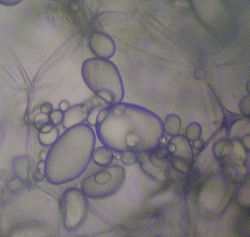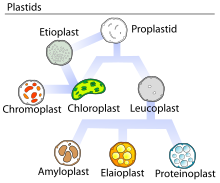ลิวโคพลาสต์

ลิวโคพลาสต์ (อังกฤษ: leucoplast; กรีกโบราณ: λευκός leukos "สีขาว", πλαστός plastos "ถูกขึ้นรูป") เป็นหมวดหมู่หนึ่งของพลาสติด ซึ่งเป็นออร์แกเนลล์ของเซลล์พืช ลิวโคพลาสต์ปราศจากรงควัตถุ ต่างจากพลาสติดชนิดอื่นเช่นคลอโรพลาสต์[1]
ลิวโคพลาสต์ไม่มีสีเนื่องจากขาดรงควัตถุที่ใช้ในการสังเคราะห์ด้วยแสง และพบได้ในในเนื้อเยื่อของพืชที่ไม่มีการสังเคราะห์ด้วยแสงเช่นราก, หัว (bulb), และเมล็ด สัณนิษฐานว่าลิวโคพลาสต์มีพัฒนาการเป็นพิเศษสำหรับการจัดเก็บแป้ง ไขมันหรือโปรตีนในจำนวนมาก มีชื่อเรียกจำเพาะว่าอะไมโลพลาสต์ (amyloplast) เอไลโอพลาสต์ (elaioplast) และโปรตีโนพลาสต์ (proteinoplast, เรียกอีกอย่างว่าอลิวโรพลาสต์, aleuroplast) ตามลำดับ อย่างไรก็ตามในเซลล์หลายชนิด ลิวโคพลาสต์ไม่ได้มีหน้าที่ในการเป็นแหล่งจัดเก็บที่สำคัญ แต่จะมีอยู่เพื่อให้เซลล์สามารถดำเนินกระบวนการสังเคราะห์ทางชีวภาพที่จำเป็นได้[2] เช่นการสังเคราะห์กรดไขมัน กรดอะมิโนและสารประกอบเตตระไพร์โรล[3] โดยทั่วไป ลิวโคพลาสต์มีขนาดเล็กกว่าคลอโรพลาสต์มาก และมีสัณฐานที่แปรผันได้ จึงถูกจัดว่ามีสัณฐานแบบอะมีบอยด์ ในเซลล์อีพิเดอร์มิสของราก, ลำต้นใต้ใบเลี้ยง, กลีบดอก, ในแคลลัสและในการเพาะเลี้ยงเซลล์แบบแขวนลอย (suspension culture) สังเกตพบเครือข่ายของสโตรมูล (stromule) ที่เชื่อมต่อระหว่างลิวโคพลาสต์แต่ละอัน ในเซลล์บางชนิด ลิวโคพลาสต์จะรวมกลุ่มกันรอบ ๆ นิวเคลียส โดยมีสโตรมูลยื่นออกไปนอกเซลล์ ดังจะสังเกตได้จากโพรพลาสติด (proplastid) ในเนื้อเยื่อเจริญบริเวณราก[4]
อีทิโอพลาสต์ (etioplast) เป็นคลอโรพลาสต์ที่ยังเจริญไม่สมบูรณ์หรือไม่ได้รับแสงมาเป็นเวลานานจนกระทั่งขาดรงควัตถุที่ทำงานได้ไป ทั้งสองอย่างนี้สามารถจัดเป็นลิวโคพลาสต์ได้ แต่หลังจากได้รับแสงเป็นเวลาหลายนาที อีทิโอพลาสต์จะเริ่มเปลี่ยนเป็นคลอโรพลาสต์ที่ทำงานได้และหยุดประพฤติตัวเป็นลิวโคพลาสต์[3] อะไมโลพลาสต์มีขนาดใหญ่และมีหน้าที่สะสมแป้ง โปรทีโนพลาสต์เก็บโปรตีนและพบในเมล็ดพืชแห้ง (pulse) เอไลโอพลาสต์เก็บไขมันและน้ำมันพบในเมล็ดพืช (เรียกได้อีกอย่างว่าโอเลโอโซม, oleosome)[4]
เปรียบเทียบ
[แก้]
- พลาสติด
- คลอโรพลาสต์และอีทิโอพลาสต์
- โครโมพลาสต์
- แทนโนโซม
- ลิวโคพลาสต์
อ้างอิง
[แก้]- ↑ Wise, Robert (13 September 2007). The Structure and Function of Plastids. Springer Science & Business Media. p. 9–10. ISBN 9781402065705.
- ↑ Pogson, B. J.; Howitt, C. A. (2006). "Carotenoid accumulation and function in seeds and non-green tissues". Plant Cell Environ (ภาษาอังกฤษ). 29 (3): 436−45. doi:10.1111/j.1365-3040.2005.01492.x. PMID 17080597.
- ↑ 3.0 3.1 Natesan SK, Sullivan JA, Gray JC (March 2005). "Stromules: A characteristic cell-specific feature of plastid morphology". Journal of Experimental Botany. 56 (413): 787–97. doi:10.1093/jxb/eri088. PMID 15699062.
- ↑ 4.0 4.1 Rainer H. Köhler and Maureen R. Hanson (2000). "Plastid tubules of higher plants are tissue-specific and developmentally regulated". Journal of Cell Science. 113: 81–89. PMID 10591627.
โครงสร้างของเซลล์ / ออร์แกเนลล์ | |
|---|---|
| ระบบเอนโดเมมเบรน |
|
| ไซโทสเกเลตัน |
|
| สิ่งมีชีวิตร่วมอาศัยภายใน | |
| โครงสร้างภายในอื่น ๆ |
|
| โครงสร้างภายนอก |
|
Text is available under the CC BY-SA 4.0 license; additional terms may apply.
Images, videos and audio are available under their respective licenses.
